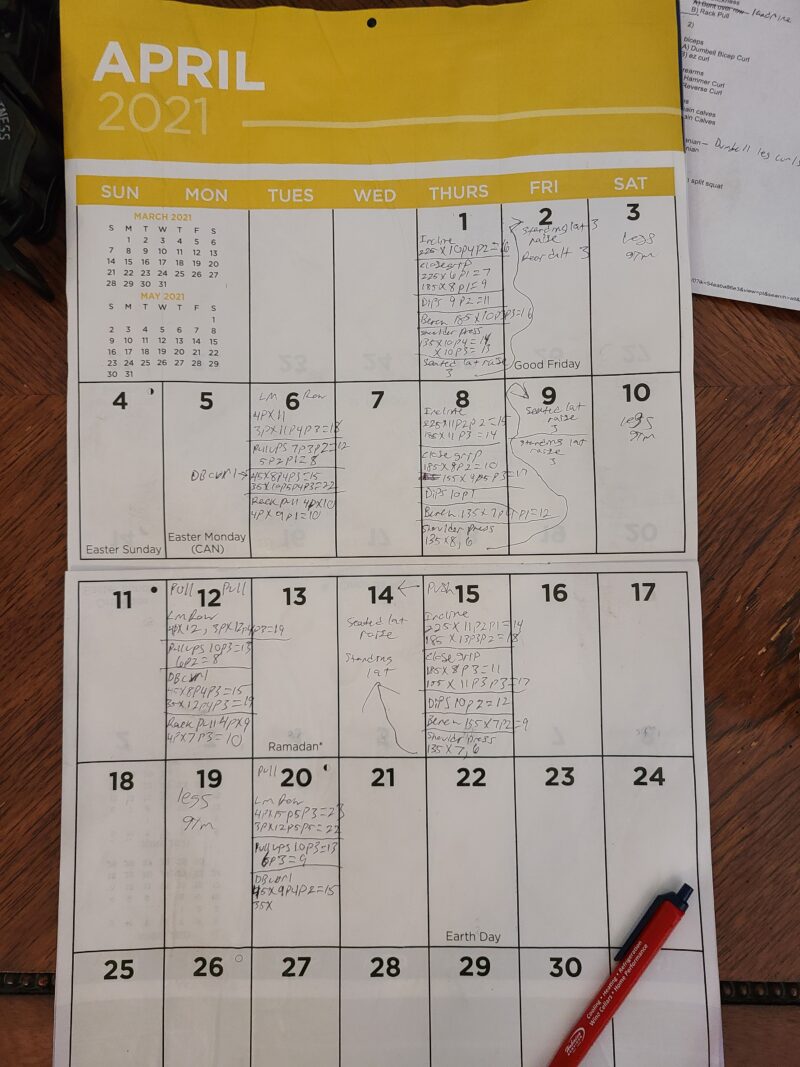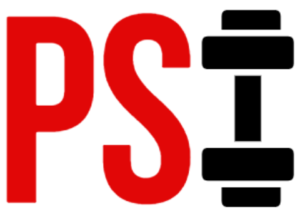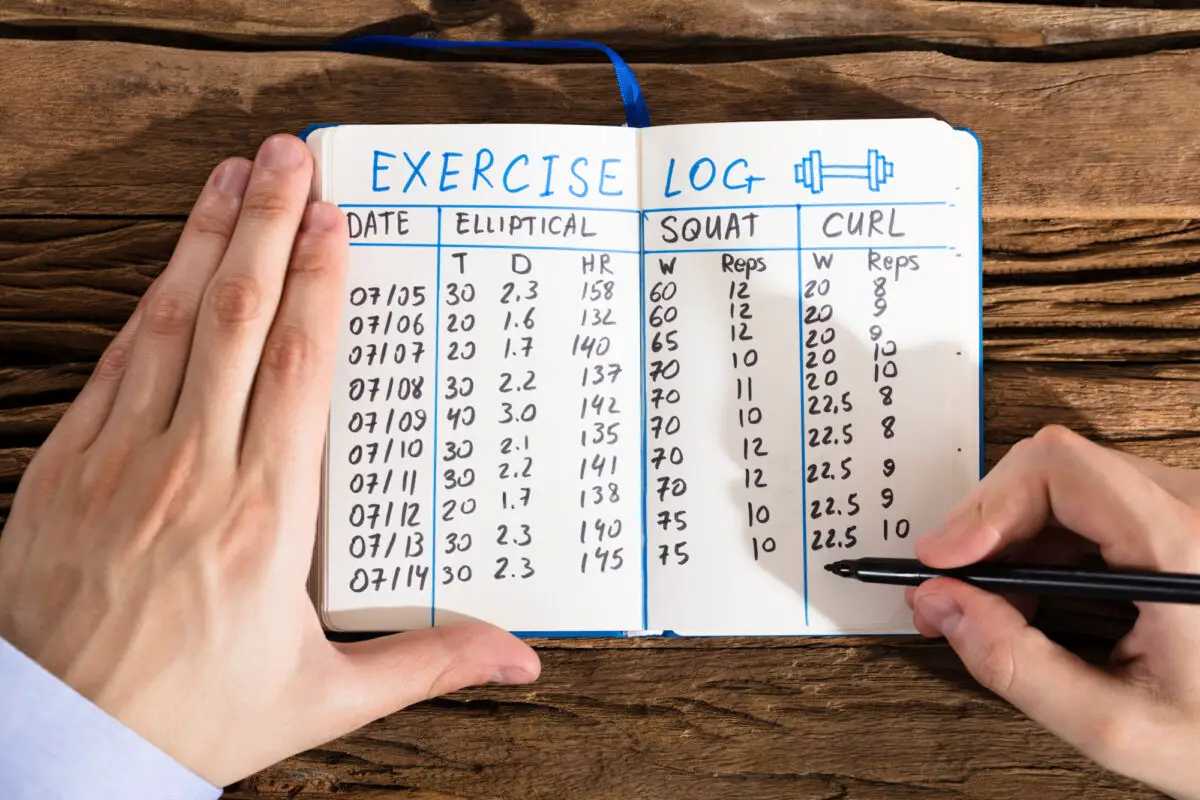You’ve probably heard of an old saying that states, “If it doesn’t get measured, it can’t be improved.”
There is a lot of truth to it, and the saying applies to almost every area of our lives – our finances, fitness, work, and more.
Many people train consistently and spend at least a bit of time to improve their nutrition, yet few ever consider, “Hm, it might be a good idea to track my progress and see where I’m headed.”
Today, we’ll go over why tracking your progress is so vital, how to go about it, what considerations you should keep in mind, and how to use a bodybuilding log book.
The Importance of Tracking Your Progress
Before we dive into this point, I’d like to present you with a hypothetical scenario. Some food for thought, if you will.
Let’s take two young guys as an example – Jake and Chris. Both of them are at the same age, and both of them start training at the same time. Both Jake and Chris train diligently and consistently, pay attention to their nutrition, and make sure to get at least seven hours of sleep per night.
But, unlike Chris, Jake also takes things a step further and tracks his progress. He is diligent with his workouts, but he is also careful about recording them. In our hypothetical scenario, we can create our own rules. So, say that they are genetically identical in terms of their ability to put on size and strength.
Within one year of serious training, which of the two would you say is going to make better progress?
Now that we have this out of the way, let’s review the importance of progress tracking.
-
It Pushes You Beyond Your Perceived Limitations
By not tracking our workouts, we often (and unknowingly) hinder ourselves and our efforts. The mind is a suggestion engine, and it often tries to stop us from doing hard work. For example, if you don’t track your performance diligently and don’t have a good idea of what you did previously, you might often feel too tired and too weak to push yourself in the present.
As you go through your warm-up sets, you might, for example, think something like, “Ah, I feel tired today. Better stick with 225 pounds on the squat. I’ll do better next time.”
But, if you log your workouts every time and you review your performance from the previous week, then, even if you feel a bit tired, you might instead think, “I feel a bit tired today, but I’ll see if I can match my performance from last week.”
Sure enough, in most cases, you can do that precisely because your mind often suggests things that aren’t entirely true. In other words, by not reviewing our progress frequently, we tend to fall within a comfort zone. We don’t slack off entirely, but we also don’t push ourselves too hard. We simply go through the motions.
-
It Keeps You Honest With Yourself
Look:
We all know that ‘hitting the gym’ is popular these days. Many people do it because it’s something cool and modern. But since we are already putting in the time, effort, and money, why not make the most of it?
The truth is, many people hit the gym, but go through the motions. One great way to push yourself harder and make better progress is to log your workouts.
Sure, it might not seem like that big of a deal. But if you open up your bodybuilding logbook and notice that you haven’t made any progress in the last month (or year), you start looking at things differently. Instead of going through yet another ‘meh’ workout, you now ask yourself, “What can I do to kickstart progress?”
As a whole, recording your workouts and reviewing your performance keeps you honest with yourself. You’re not wondering whether you’ve improved, and you have no excuse to lie to yourself that you have.
Help Support PSI: Pump Some Iron is an Ice Shaker affiliate. Click this link to check out the stainless steel shaker cup that stays cold for 30 hours! Your purchase directly supports our effort to put out quality content on training and nutrition. Thank you!

-
It Allows You to Make Changes on the Go And Kickstart Progression
This point ties in with the previous one on being honest with yourself. Looking at your workouts and performance gives you actionable data, which you can use to make better decisions about your training, nutrition, and recovery.
For example, if you never log your works and you don’t have a good idea of what your performance looks like, you may not notice that your strength has been dropping steadily in the last four weeks.
But, if you track your workouts and notice that you’re doing a little bit worse with each session, that could be indicative of overtraining (1). So, you can evaluate yourself and decide that you need to have a week of light training, for example.
On the other hand, if you track your performance and notice that things are going fantastic, you can decide to keep things the same and milk your current training for every ounce of progress you can.
But, again, to get this data, you need to be recording your workouts.
-
It Works Great With Other Measures of Progression
We often look at things in isolation, and that can be harmful in the long run. Take, for example, fat loss. Most people who want to shed fat only look at a single metric of progress – their scale weight.
When scale weight is steadily going down, everything is fine. But, if scale weight plateaus for a week or two, people enter panic mode. Sure, that plateau can be an indicator that they are no longer in a calorie deficit and need to change something if they want to progress further (2). But, in many cases, this could simply be some water retention that is bound to resolve itself.
Workout logging is particularly great because we can use it with other measures of progress and gain more accurate data on how things are going. Consider, for example, a bodybuilding offseason (bulking, gaining, or however you typically refer to it):
Logging your workouts is of utmost importance because you get to see if your performance improves (3):
- Are you lifting more weight?
- Are you doing more total repetitions?
- Are you doing more sets and/or workouts within each week?
- Are you doing the same workout, but in less time?
Each of these can be indicative of progress and muscle growth. And, if you use these measures in combination with weight gain, progress pictures, and circumference measures, you can get a pretty good idea of how things are going.
So, if:
- Your performance is steadily improving;
- Your circumferences are going up;
- Your progress pictures show that you’re steadily becoming more muscular;
- You’re gaining weight steadily (about 0.25 percent of body weight per week); (4)
You can conclude that your bulking phase is going well. But, if you instead only take the occasional progress photo, track your weight here and there, and never take circumference measures, you won’t be able to see a clear trajectory.
Because of that, keeping a bodybuilding log book and tracking other measures concurrently is so beneficial for your long-term development.
Simply put, its important you track your workouts because doing so will potentially help you make progress. Beating the logbook will only lead to improving your physique. A workout journal is a valuable tool that anyone, who wants to make progress, should take advantage of.
The Bodybuilding Log Book – The Simple Process You Can Use to Achieve Your Goals
There are many ways to record your training. You can go with a simple workout app, a workout journal, or something else. One thing is clear: we should all do it.
Now, before we get into the practical how-to’s, let’s first review what recording your workouts should accomplish:
- It should allow you to record the most critical metrics. More specifically:
- The exercises you’re doing
- The number of sets you’re doing them for
- The number of reps you’re getting on each set
- The weight you’re lifting
If you’re more pedantic, you can also record metrics such as:
- How long you rest between sets
- What your rate of perceived exertion (RPE) is on each set. Alternatively, you can use reps in reserve (RIR) value.
- What goals you have for each session
- Notes on individual exercises and workouts – does an exercise feel right, do you feel any pains or aches, do you feel stiff and immobile, how you feel on a particular day, and such.
- What your body weight is on that day – it can be particularly useful if your workouts include bodyweight exercises like pull-ups.
- It should be quick and easy to record. The smoother the logging process is, the more time you can spend on working out, and the more consistent you will be with the recording process.
You don’t want to be spending up to half an hour, logging each workout.
- It should be versatile, and you should be able to easily change things up if you decide to try a different training style or program.
With all of that out of the way, here is your three-step process for using a bodybuilding logbook:
-
Start With Date
At the top, record the date of the workout and include your body weight for that day (if you have the value and your workout includes bodyweight movements).
-
Write Down Your Exercises And Sets
I avoid filling in everything beforehand because if I end up failing to hit my numbers, I have to go back and make a mess on the page. So, for example:
Exercise #1 – 3 sets
Exercise #2 – 4 sets
Exercise #3 – 3 sets
And so on. Once you’ve filled the page with the exercises and numbers of sets, move to step number three:
-
Add The Weight You’ll Be Using
Once you have your exercise and the corresponding number of sets written down, it’s time to put down the amount of weight you’ll be lifting. It’s best to write it once you’ve gone past your warm-up sets.
For example:
Flat barbell bench press – 4 sets w/ 100 kg
Then, as you do each set, note the number of reps down:
Flat barbell bench press – 4 sets w/ 100 kg for 8, 8, 7, 6 (for example)
The added benefit is that by writing your repetitions after each set, you don’t lose count on how many more you have left before it’s time to move to the next exercise.
Below is a Jumbo Grid Calendar that I use as a training log in my garage gym. I think it works great and have been doing it for years. When I go to the gym, I use a Moleskine classic notebook to track my progress. Its pocked sized and is easy to take with you. Click this link if you would like to see the notebook I use on amazon.

Two Observations About Workout Logging
Here are some ideas to further help you with your workout logging:
-
The Ease
Using a physical notebook or journal is fantastic and convenient because you can easily refer to your previous workouts as they are no more than a few flips of pages away.
Alternatively, you can also use your phone to record your workouts, but that can be harmful if you tend to then get on social media or Youtube and waste several minutes on scrolling.
-
The Details
By pre-recording your exercises, numbers of sets, and weight, you make it much easier to then write down the number of reps you do on each set quickly, and without slowing down your workout. Plus, that’s a fantastic way to keep count of the number of sets you’ve already done.
A Few Considerations to Keep in Mind
Before we wrap up this guide, here are a few essential considerations to keep in mind:
-
Don’t Become Goal-Obsessed
Goals are by no means a bad thing. They serve to give direction to our efforts and focus. Without them, most of us would wander, never knowing what to focus on.
But, just as goals can be beneficial and motivating, they can also hinder our long-term development.
And sure, we all have our fitness and training goals. Some folks want to bench press 315 pounds, others want to build 17-inch arms, and many want to lose, say, 20 pounds of fat. There is nothing wrong with any of these.
But, where most people go wrong with goals is that they become obsessed with the outcome and forget about the process behind it. Sure, you want to squat a certain amount of weight. But obsessing over the goal won’t get you there; squatting will.
What’s more, there is also an argument to be made about proper training form. In their pursuit of a strength-based goal, many people sacrifice their technique to achieve the outcome sooner. A good example here is the squat. If you become too obsessed over squatting a given weight, you might unknowingly start sacrificing your technique so that you can achieve the goal quicker.
But, if you can squat 275 pounds with perfect form and rush to half-squat 315 pounds, then did you genuinely achieve the goal?
So, focus more on the processes behind your goals, and you will find yourself a lot more successful and fulfilled in the long run.
Because of that, we don’t recommend writing specific training goals in your bodybuilding log book. That can take away your focus from what matters most (following through with a sound and productive workout and using proper technique on every repetition) and into the thing that doesn’t matter at the moment (your long-term goal).
Suggestion: Check out another article on Pump Some Iron: Triceps Training Tips for Growth

-
Progress (or Lack Thereof) Is Not Always Informative
Seeing progress is an incredibly rewarding and motivating thing. Improving and having proof of that is what we all want from our training. But, the problem is, what we write down doesn’t always give us the whole picture. Yes, it’s a bit confusing, I know.
Let’s take the barbell back squat as an example. Say that last week, you managed to squat 100 kilos for five sets of 8 reps. Then, this week, you only squatted 100 kilos for five sets of 8, 8, 7, 6, and 5 reps.
Did you regress in the last seven days? Well, you very well could have. But, a more likely explanation is that it’s just not your day. Maybe you didn’t get enough sleep or food (5). Or perhaps you’re a bit more tired or stressed than usual.
But seeing improvements in performance certainly is informative, right?
Well, not always.
We all have our great workouts – everything feels solid, the warm-up goes fantastic, the bar moves with the speed of light, and we just know that we are about to crush it. Those workouts are a blessing. But, much like our bad workouts, these too tend to be outliers.
In other words, even if you do see an unusual improvement in your performance on a given workout, that may not be indicative of long-term progress. On the very next week, you might find yourself back to your general performance.
So, what does this all mean in the practical sense?
Well, it mostly means that we shouldn’t put too much stock in our performance on a given workout. Instead, we should look at our workouts over weeks and see what the general trend is.
-
Measuring Forward May Not Always Be Ideal
We often go about setting goals and forcing ourselves to measure forward like this:
- I want to increase my bench press by 45 pounds in the next ten weeks.
- I want to lose 20 pounds of fat within twelve weeks.
- I want to run a sub-six-minute mile in the next three months.
In other words, we look into the future and try to make accurate predictions of where we will be within a given time frame. But, when it comes to making steady fitness progress forward, it might be more useful to measure backward.
For example, as you finish a training week, set aside some time, and open up your bodybuilding log book. Then, review your performance over the week and as it relates to previous weeks. In as little as twenty minutes, you can gain real insight into whether or not you’re making good progress in the areas that matter most. If you’re improving, you can keep things the same for the upcoming week. However, if things aren’t moving in the right direction, you can adjust the course for the following training sessions.
For example, say that you want to improve your performance on the pull-up. As the training week wraps up, you can open up your log book and review your recent performance. So, say that things haven’t been going so well:
Current week:
Monday – 4 sets x 10, 7, 5, 4, 4 reps (30 total reps)
Thursday – 5 sets x 11, 6, 4, 4, 3, 3 reps (31 total reps)
Previous week:
Monday – 4 sets x 13, 8, 5, 5 reps (31 total reps)
Thursday – 5 sets x 12, 8, 6, 5, 4, 3 reps (38 total reps)
And even better performance in the week before. There is a trend for decreased performance – the very opposite of what you want. So, what you can do for the upcoming week is adjust course and maybe try to spread out your repetitions more evenly. Like so:
Next week’s goals:
Monday – 7 sets x 5, 5, 5, 5, 5, 5, 5
Thursday – 8 sets x 6, 6, 6, 5, 5, 5, 5, 5
This is just one example of how you can apply this, but the principle applies to many different situations. Review your performance, and if you notice a trend for regression, make small changes, and see if they result in improvements.
-
Start With Less Data, Rather Than More
We get it. This is something new, and you’re excited to try it out. You want to track all the metrics and gain a lot of in-depth data about your training and performance.
But, the best thing you can do in the beginning is to take a deep breath and start small. Sure, you can start tracking all of the metrics from day one, but that’s not ideal. A much better alternative is to start with your exercises, sets, reps, and weights – that’s it.
Write down just these metrics for a few weeks to establish the habit of logging your workout. Then, once you’ve built some momentum, you can start introducing other things, and maybe even start playing with more nuanced things like rate of perceived exertion (RPE).
But, if you start with incredibly detailed workout reports right from the start, you are much more likely to start feeling like you’re tracking more than you’re training. That’s a great way to burn yourself out and give up before you’ve even begun.
Thank you for reading! If you liked this article, please share it and then go Pump Some Iron!
Follow me / Pump Some Iron on Instagram for updates @pump.some.iron

